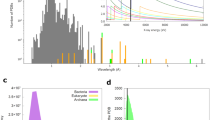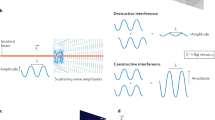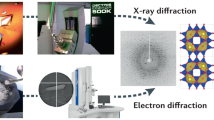Abstract
We describe a likelihood-based method for determining the substructure of anomalously scattering atoms in macromolecular crystals that allows successful structure determination by single-wavelength anomalous diffraction (SAD) X-ray analysis with weak anomalous signal. With the use of partial models and electron density maps in searches for anomalously scattering atoms, testing of alternative values of parameters and parallelized automated model-building, this method has the potential to extend the applicability of the SAD method in challenging cases.
This is a preview of subscription content, access via your institution
Access options
Subscribe to this journal
Receive 12 print issues and online access
$259.00 per year
only $21.58 per issue
Buy this article
- Purchase on Springer Link
- Instant access to full article PDF
Prices may be subject to local taxes which are calculated during checkout



Similar content being viewed by others
Accession codes
Accessions
Protein Data Bank
References
Berman, H.M. et al. Nucleic Acids Res. 28, 235–242 (2000).
Hendrickson, W.A. & Teeter, M.M. Nature 290, 107–113 (1981).
Wang, B.-C. Methods Enzymol. 115, 90–112 (1985).
Weeks, C.M., DeTitta, G.T., Miller, R. & Hauptman, H.A. Acta Crystallogr. D Biol. Crystallogr. 49, 179–181 (1993).
Schneider, T.R. & Sheldrick, G.M. Acta Crystallogr. D Biol. Crystallogr. 58, 1772–1779 (2002).
de La Fortelle, E. & Bricogne, G. Methods Enzymol. 276, 472–494 (1997).
McCoy, A.J., Storoni, L.C. & Read, R.J. Acta Crystallogr. D Biol. Crystallogr. 60, 1220–1228 (2004).
Pannu, N.S. & Read, R.J. Acta Crystallogr. D Biol. Crystallogr. 60, 22–27 (2004).
Langer, G., Cohen, S.X., Lamzin, V.S. & Perrakis, A. Nat. Protoc. 3, 1171–1179 (2008).
Liu, Q. et al. Science 336, 1033–1037 (2012).
Skubák, P. & Pannu, N.S. Nat. Commun. 4, 2777 (2013).
Weiss, M.S., Sicker, T. & Hilgenfeld, R. Structure 9, 771–777 (2001).
Barends, T.R. et al. Nature 505, 244–247 (2014).
McCoy, A.J. & Read, R.J. Acta Crystallogr. D Biol. Crystallogr. 66, 458–469 (2010).
Read, R.J. & McCoy, A.J. Acta Crystallogr. D Biol. Crystallogr. 67, 338–344 (2011).
Grosse-Kunstleve, R.W. & Adams, P.D. Acta Crystallogr. D Biol. Crystallogr. 59, 1966–1973 (2003).
Adams, P.D. et al. Acta Crystallogr. D Biol. Crystallogr. 66, 213–221 (2010).
Sheldrick, G.M. Acta Crystallogr. D Biol. Crystallogr. 66, 479–485 (2010).
Terwilliger, T.C. Acta Crystallogr. D Biol. Crystallogr. 56, 965–972 (2000).
Terwilliger, T.C. et al. Acta Crystallogr. D Biol. Crystallogr. 65, 582–601 (2009).
Terwilliger, T.C. et al. Acta Crystallogr. D Biol. Crystallogr. 64, 61–69 (2008).
Blanc, E. et al. Acta Crystallogr. D Biol. Crystallogr. 60, 2210–2221 (2004).
Terwilliger, T.C. Acta Crystallogr. D Biol. Crystallogr. 59, 1174–1182 (2003).
Perrakis, A., Sixma, T.K., Wilson, K.S. & Lamzin, V.S. Acta Crystallogr. D Biol. Crystallogr. 53, 448–455 (1997).
Read, R.J. Acta Crystallogr. A Found. Adv. 42, 140–149 (1986).
Levin, I. et al. Proteins 59, 864–868 (2005).
Xu, Q. et al. Proteins 62, 292–296 (2006).
Kozbial, P. et al. Proteins 71, 1589–1596 (2008).
Xu, Q. et al. Structure 17, 303–313 (2009).
Dauter, Z., Wilson, K.S., Sieker, L.C., Meyer, J. & Moulis, J.M. Biochemistry 36, 16065–16073 (1997).
Xu, Q. et al. Proteins 69, 433–439 (2007).
Xu, Q. et al. Proteins 74, 1041–1049 (2009).
Hwang, W.C. et al. Proteins 10.1002/prot.24679 (1 September 2014).
Abendroth, J. et al. J. Struct. Funct. Genomics 12, 83–95 (2011).
Martinez-Rucobo, F.W., Sainsbury, S., Cheung, A.C. & Cramer, P. EMBO J. 30, 1302–1310 (2011).
Chattopadhyay, K., Ramagopal, U.A., Brenowitz, M., Nathenson, S.G. & Almo, S.C. Proc. Natl. Acad. Sci. USA 105, 635–640 (2008).
Cianci, M., Helliwell, J.R. & Suzuki, A. Acta Crystallogr. D Biol. Crystallogr. 64, 1196–1209 (2008).
Fabian, M.R. et al. Nat. Struct. Mol. Biol. 20, 735–739 (2013).
Tanaka, Y. et al. RNA 15, 1498–1506 (2009).
Thomas, S.R., McTamney, P.M., Adler, J.M., LaRonde-LeBlank, N. & Rokita, S.E. J. Biol. Chem. 284, 19659–19667 (2009).
de Graaff, R.A.G., Hilge, M., van der Plas, J.L. & Abrahams, J.P. Acta Crystallogr. D Biol. Crystallogr. 57, 1857–1862 (2001).
Winn, M.D. et al. Acta Crystallogr. D Biol. Crystallogr. 67, 235–242 (2011).
Panjikar, S. et al. Acta Crystallogr. D Biol. Crystallogr. 61, 449–457 (2005).
Wang, J.W. et al. Acta Crystallogr. D Biol. Crystallogr. 60, 1991–1996 (2004).
Burla, M.C. et al. J. Appl. Cryst. 45, 357–361 (2012).
Terwilliger, T.C. & Berendzen, J. Acta Crystallogr. D Biol. Crystallogr. 55, 849–861 (1999).
Emsley, P. & Lohkamp, B. Acta Crystallogr. D Biol. Crystallogr. 66, 486–501 (2010).
Acknowledgements
We thank Q. Liu, W. Henderickson and colleagues for generously providing the CysZ sulfur SAD data sets. Support received from the US National Institutes of Health (grant P01GM063210 to P.D.A., T.C.T. and R.J.R. and grant GM073210 to J.M.H.) and the Wellcome Trust (Principal Research Fellowship to R.J.R., grant 082961/Z/07/Z) is gratefully acknowledged. This work was partially supported by the US Department of Energy under contract DE-AC02-05CH11231.
Author information
Authors and Affiliations
Contributions
R.J.R. and T.C.T. led the work; R.J.R. and A.J.M. developed the likelihood-based scoring and LLG maps in Phaser; R.W.G.-K. and P.D.A. developed the HySS framework; J.M.H. developed the synthetic data tests; N.E., T.C.T. and G.B. integrated the likelihood-based methods into HySS; T.C.T. carried out the tests and optimized the Phenix AutoSol and AutoBuild algorithms.
Corresponding authors
Ethics declarations
Competing interests
The authors declare no competing financial interests.
Integrated supplementary information
Supplementary Figure 1 Comparison of Phenix with Crank2 structure determination using sites found by Shelxc/d.
Comparison of Phenix and Crank2 structure determination as in Fig. 3c, except that substructure determination was carried out by Shelxc/d5,18 in the Crank2 analysis.
5. Schneider, T. R. & Sheldrick, G. M. (2002). Acta Cryst. D58, 1772–1779.
18. Sheldrick, G. M. (2010). Acta Cryst. (2010). D66, 479–485.
Supplementary Figure 2 Comparison of Phenix with Crank2 structure determination using sites found with Crunch2.
Comparison of Phenix and Crank2 structure determination as in Fig. 3c, except that substructure determination is carried out by Crunch243 in the Crank2 analysis. Values of map correlation from –0.015 to 0.0 are displayed as zero for clarity.
43. Graaff, R.A. G. de, Hilge, M., van der Plas, J. L. & Abrahams, J. P. (2001). Acta Cryst. D57, 1857-1862.
Supplementary Figure 3 Application of substructure completion algorithms to a series of challenging synthetic data sets.
All algorithms were tested using default parameters except as noted. SOLVE42 (filled orange circles). HySS dual-space substructure identification16 (filled blue squares), and HySS likelihood-based substructure identification (default procedure, black filled circles, brute-force procedure, open black circles) were carried out in Phenix17, whereas Crunch243 (purple open squares) and Shelxc/d5,18 (1000 tries, blue closed circles and 100,000 tries, green closed circles) substructure determinations were carried out using the Crank2 CCP4i interface41.
5. Schneider, T. R. & Sheldrick, G. M. (2002). Acta Cryst. D58, 1772–1779.
16. Grosse-Kunstleve, R.W & Adams, P.D. (2003). Acta Cryst. D59, 1966–1973.
17. Adams, P. D. et al. (2010). Acta Cryst. D66, 213–221.
18. Sheldrick, G. M. (2010). Acta Cryst. (2010). D66, 479–485.
41. Winn, M.D. et al. (2011). Acta Cryst. D67, 235-242.
42. Terwilliger, T.C. & Berendzen, J. (1999). Acta Cryst. D55, 849-861.
43. Graaff, R.A. G. de, Hilge, M., van der Plas, J. L. & Abrahams, J. P. (2001). Acta Cryst. D57, 1857-1862.
Supplementary Figure 4 Mean Z scores for trial substructures depending on the number of correct sites.
Scoring was carried out by correlation of structure factor amplitudes (open symbols) or likelihood (closed symbols). Z-scores were averaged for merged datasets with anomalous signal less than or greater than 7.5 as defined in the legend to Fig. 1.
Supplementary Figure 5 Distribution of likelihood-based scores.
Distribution of likelihood-based scores for merged CysZ dataset based on crystals 2,3 and 7. LLG scores are plotted as a function of the number of sites in the substructure for 3781 trial substructures considered during Phenix brute-force substructure determination. Solutions with 0 or 1 correct sites are indicated with crosses, those with 2–4 correct sites with solid purple circles, and solutions with 19 or more correct sites with solid blue circles (no solutions were obtained with 5–18 correct sites).
Supplementary Figure 6 Map correlation as function of anomalous signal for SAD data sets from the PDB after parallel autobuilding.
Phenix structure determination was carried out as in Fig. 3b, then the resulting density-modified maps were used as the starting point for parallel model-building as described in the text.
Supplementary Figure 7 Effects of optimizations on performance of Phenix structure determination.
Each panel contains the same datasets that are shown in Figs. 3a and 3b, and the map correlation to the model-phased electron density map is shown for each dataset and each treatment. (a) Comparison of using only data corrected for anisotropy and sharpened to an effective overall B-value of 10 times the resolution (i.e., if the data extend to 2.5 A the B-value was set to 25 A2) with using these data in parallel with uncorrected data in substructure determination and including substructures obtained with each approach in the analysis. (b) Comparison of using only a dual-space substructure search with using dual-space and likelihood-based searches in parallel. (c) Comparison of not using parameter testing or iteration of substructure searches with using both.
Supplementary Figure 8 Map correlation after structure determination based on synthetic data sets.
Map correlation is relative to the map based on starting coordinates in the simulation. Filled triangles are map correlations for final maps from Crank2, open squares from Phenix Autosol/Autobuild, closed circles from Phenix Autosol followed by parallel autobuilding and map averaging as described in the text.
Supplementary information
Supplementary Text and Figures
Supplementary Figures 1–8 (PDF 1374 kb)
Data for Figures 1a, 1b
Spreadsheet containing the data and calculations for Figures 1a and 1b (XLSX 146 kb)
Data for Figures 2a, 2b
Spreadsheet containing the data and calculations for Figures 2a and 2b. See Supplementary Data 8 for the datasets used in this analysis. (XLSX 58 kb)
Data for Figures 3a,3b,3c Supplemental Figures 1,2,6,7
Spreadsheet containing the data and calculations for Figures 3a,3b,3c Supplemental Figures 1,2,6,7 (XLSX 142 kb)
Data for Supplemental Figure 3
Spreadsheet containing the data and calculations for Supplemental Figure 3 (XLSX 57 kb)
Data for Supplemental Figure 4
Spreadsheet containing the data and calculations for Supplemental Figure 4 (XLSX 56 kb)
Data for Supplemental Figure 5
Spreadsheet containing the data and calculations for Supplemental Figure 5 (XLSX 215 kb)
Data for Supplemental Figure 8
Spreadsheet containing the data and calculations for Supplemental Figure 8 (XLSX 50 kb)
Merged scaled CysZ datasets used for Figures 2a and 2b
This file contains scaled, merged data used in Fig. 2 of this paper. See Supplementary Data 2 for details of results of analysis of this data. The original data are available at: http://x4.nsls.bnl.gov/native-SAD/CysZ_native-SAD_individual_plus_merged.tar.bz2. The datasets from Q. Liu and W. Hendrickson have names CysZ_XX_TOMT_scala.sca. These datasets were renamed and rescaled with SOLVE local scaling to yield merged datasets with varying numbers of contributing datasets. The renaming was done in an attempt to sort the datasets based on completeness so that scaling could be easily done starting with dataset “1” and then followed by adding other datasets. The correspondence between the original datasets and renamed/rescaled datasets is given below: XX in CysZ_XX_TOMT_scala.sca rescaled data number 2 1 7 2 3 3 4 4 5 5 6 6 1 7 For example: CysZ_7_TOMT_scala.sca is merged and called merge_2.sca Merge of CysZ_2_TOMT_scala.sca and CysZ_6_TOMT_scala.sca is called merge_16.sca (ZIP 15465 kb)
Source data
Rights and permissions
About this article
Cite this article
Bunkóczi, G., McCoy, A., Echols, N. et al. Macromolecular X-ray structure determination using weak, single-wavelength anomalous data. Nat Methods 12, 127–130 (2015). https://doi.org/10.1038/nmeth.3212
Received:
Accepted:
Published:
Issue Date:
DOI: https://doi.org/10.1038/nmeth.3212
This article is cited by
-
Selenium single-wavelength anomalous diffraction de novo phasing using an X-ray-free electron laser
Nature Communications (2016)



